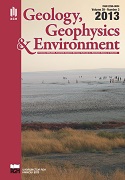The comparison of the results of laser scanning and classical surveying methods of measuring the area and volume in the chapel of St. Kinga in the salt mine of Bochnia
DOI:
https://doi.org/10.7494/geol.2013.39.3.211Keywords:
mining deformations, Salt Mine Bochnia, area convergence, laser scanningAbstract
Providing a long durability of the historic salt mine of Bochnia demands proper observations, analyses and drawing conclusions based on them and leading to recognising and the assessment of a specific behaviour of the rock mass and the effectiveness of the protection from mining damage. The studies of the rock mass and surface deformation are carried out by the mine based on the results of the observations made with the methods of surveying. These observations include, among others, the measurements of the height of benchmarks stabilized on the surface and rock mass, the measurements of linear convergence (on the established vertical and horizontal bases in selected chambers of the mine); and since 2003 the attempts have been made to apply total stations and laser scanners to document the selected chambers. The article presents test studies on laser scanning carried out in the chapel of St. Kinga in the Bochnia Salt Mine in 2007 and 2013 (Fig. 1). They showed high accuracy of the scanning method both in the positioning of points of the salt excavation, in modelling, as well as calculation of the area of any cross-section (Fig. 2) and the volume of chambers of complicated shapes (Fig. 3). The carried out accuracy studies, analyses and comparisons were used in the calculation of the area convergence for the chapel of St. Kinga in the Bochnia Salt Mine. They make base for the calculation of volume do convergence in the near future.
Downloads
References
Kortas G., Szewczyk J. & Toboła T., 2004. Ruch górotworu i powierzchni w otoczeniu zabytkowych kopalń soli. Wydawnictwo IGSiE, Kraków.
Maciaszek J. (manager), 2007. Badanie możliwości stosowania skanerów laserowych do inwentaryzacji, wizualizacji i monitoringu obiektów inżynierskich i górniczych. Projekt badawczy nr 4T12E 05729 [unpublished].
Maciaszek J. & Gawałkiewicz R., 2007. Badanie dokładności tachimetrów i skanerów laserowych w warunkach laboratoryjnych i polowych. Zeszyty Naukowe Politechniki Śląskiej, Górnictwo, 278, Gliwice.
Maciaszek J., 2008. Skanowanie laserowe jako nowa technologia inwentaryzacji i wizualizacji zabytkowych komór solnych. Gospodarka Surowcami Mineralnymi, 24, 3/2, 197-210.
Maj A., 2012. Convergence of gallery workings in underground salt mines. Archives of Mining Sciences, Monograph, 14, 1-112.
Rozporządzenie Ministra Środowiska z dnia 22 grudnia 2011 r. w sprawie dokumentacji mierniczo-geologicznej. Dz.U. 2011, nr 291, poz. 1713.
Downloads
Published
Issue
Section
License
Authors have full copyright and property rights to their work. Their copyrights to store the work, duplicate it in printing (as well as in the form of a digital CD recording), to make it available in the digital form, on the Internet and putting into circulation multiplied copies of the work worldwide are unlimited.
The content of the journal is freely available according to the Creative Commons License Attribution 4.0 International (CC BY 4.0)










